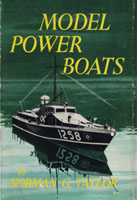|
|
N. Taylor
Model Power Boats
This authoritative guide to the
building of working model power
boats covers the three basic groups —
scale models, semi-scale models in
which modifications are made to
simplify construction and increase
efficiency, and functional models in
which appearance is sacrificed to
obtain the utmost speed.
An early chapter is devoted to the
essential theory behind the design of
power boats; then follows instruc-
tion on how to design a model and
how to draw up full-size working
plans, A section on power units
covers the various types of internal
combustion engines, electric motors,
steam engines and Jetex motors avail-
able for use. Subsequent chapters
deal with the construction of the hull
in wood and in metal, and the fitting
of the superstructure, the problems of
transmission and the correct use of
propellers. The closing section covers
the use of constructional kits, and
provides detailed specifications and
a glossary of technical terms.
|

|
|
|